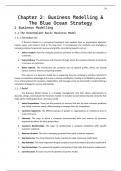24
Chapter 2: Business Modelling &
The Blue Ocean Strategy
1 Business Modelling
1.1 The Osterwalder Basic Business Model
1.1.1 Introduction
A Business Model is a conceptual framework that explains how an organization operates,
creates value, and sustains itself in the long term. It encompasses the methods and strategies a
company employs to generate revenue and profits, considering aspects such as:
• Value Creation: How the company produces products or offers services that are valuable to
customers.
• Value Delivery: The processes and channels through which the company delivers its products
or services to customers.
• Value Capture: The mechanisms the company uses to capture profits, which can include
various revenue streams and pricing models.
The essence of a business model lies in explaining how the company’s activities interlink to
create a competitive advantage and ensure customer satisfaction, leading to profitability and growth.
It is a critical element for investors, stakeholders, and managers who are interested in understanding a
company’s strategy for success and viability.
1.1.2 Model
The Business Model Canvas is a strategic management tool that allows organizations to
describe, design, and analyze their business models. It includes several interconnected elements that
make up the building blocks of a business model:
1. Value Propositions: These are the products or services that aim to solve customer problems
and satisfy customer needs, differentiating a company from its competitors.
2. Customer Segments: The different groups of people or organizations an enterprise aims to
reach and serve.
3. Channels: The ways in which a company communicates with and reaches its customer
segments to deliver its value proposition.
4. Customer Relationships: The types of relationships a company establishes with specific
customer segments.
5. Revenue Streams: The cash a company generates from each customer segment.
6. Key Resources: The most important assets required to make a business model work.
7. Key Activities: The most important things a company must do to make its business model work.
8. Key Partnerships: The network of suppliers and partners that make the business model work.
9. Cost Structure: All costs incurred to operate a business model.
, 25
By mapping out these elements, companies can create a clear picture of how they operate and
generate value. It’s a living document that can be updated and adjusted as the company grows or as
market conditions change. This approach to business modeling helps ensure that a company remains
customer-focused, value-driven, and operationally efficient.
Grameen’s business model




